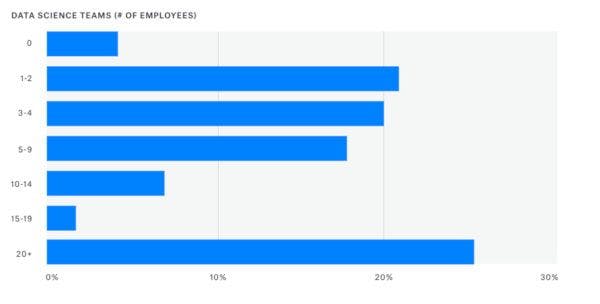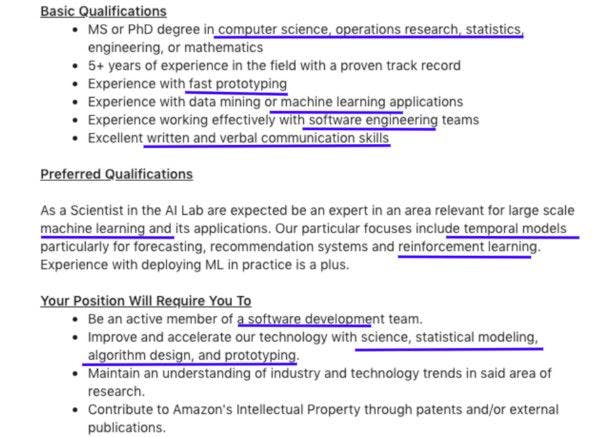How to Build the Perfect Resume to Land a Data Science Role

Looking to make your data science resume more attractive to employers? You’re in the right place. In this post, you’ll find expert tips, examples, and takeaways to make a resume that’s good enough for the job you really want.
What are Data Science Employers Looking for in a Resume?
Let’s begin by thinking like a data science recruiter for a moment. To stand out from the pile of other resumes and catch the attention of employers, we need to know what they’re looking for in candidates.
These are the most important skills that attract employers:
- Education (at least a Bachelor’s degree in Computer Science, Social Sciences, and Statistics)
- R programming
- Python Coding
- Hadoop platform
- SQL database/coding
- Apache Spark
- Machine Learning and Artificial Intelligence
- Data Visualization
- Unstructured data.
So, as someone interested in hiring a data scientist, you’ll be more likely to look for these skills in the resume. This brings us to the first tip…
1. Put In-Demand Skills First
To save the hiring manager the trouble of looking for your skills, put them at the very top of your resume. Be sure to list them in a separate section to catch your attention. Don’t use a one-column bullet list for skills – you don’t want to take up a lot of space with this list. If you’re not using any templates where the designer took care of space-saving, you can simply list them in one sentence.
In which order should you list the skills? The best bet is to have in-demand skills first and move on to less impressive skills. It can also be helpful to provide your evaluation of the skill level, e.g., “beginner, “intermediate,” or “expert.”
Takeaway: List your skills close to the top of your resume. They will help to draw the attention of the hiring manager and let them know if you’re the right candidate for the job.
2. Give a Detailed and Concise Overview of Your Achievements
This is another critical section that deserves to be near the top of your resume. It is the “Show, don’t tell” part that hiring managers want. Your main goal is to find and list your main professional achievements.
Here’s how to do it right:
- Use only relevant achievements. An achievement like “Providing expert dissertation help to students to improve their academic writing skills” sounds impressive, but stick to data science-related accomplishments
- Include numbers. A quantifiable accomplishment demonstrates your impact much better, e.g., “Analyzed marketing processes with custom machine learning algorithms to generate $20K in savings” is more impressive with numbers
- Use only one sentence per achievement. Your resume should fit on one page, so be careful and limit each achievement to one sentence.
Pro tip: Use the “Skill – Activity – Result” formula for each achievement.
- Skill: using custom machine learning algorithms
- Activity: marketing process analysis
- Result: $20K in savings.
These are the parts that make up the “Analyzed marketing processes with custom machine learning algorithms to generate $20K in savings” example. By structuring the achievements this way in your resume, you’ll make them to the point and clear.
3. Explain, Don’t List, Your Non-Technical Skills
Many data scientists make the mistake of presenting their soft skills in a bullet point list. What does something like “verbal communication” really say about you to the person reading your resume? You need detail.
Below are some examples.
- Verbal communication: Managed weekly meetings with clients to update them on projects and collect feedback
- Written communication & teamwork: Worked with a team of 10+ marketers, applying data analysis models to identify patterns in customer data
- Storytelling: Created data visualization presentations and presented them to customers to explain the results of data analysis
- Adaptability: Worked simultaneously on machine learning and data visualization projects to help identify unexpected problems & convert results into visual
Now, that sounds more interesting, right? The hiring manager reading your resume will agree. Communication and teamwork are among the most important soft skills to present this way. Why? Because the majority of data science professionals – about 60 percent – work in teams of five or more people, says the State of Data Science 2019 report.

Source: State of Data Science 2019
The only thing to remember when describing these non-technical skills is to write only one sentence for each one (just like with the achievements).
4. Match Keywords in the Job Description
It’s not a secret that hiring managers use keywords in job descriptions. In the data science industry, they include the names of skills, qualifications, certifications, and technologies.
Let’s take a look at this data scientist job posting. The posting has most of the keywords underlined for you to find quickly.

See how many of them are there?
This job posting is literally packed with the keywords that the perfect candidate should have on their resume (that means you, too, if you’re applying).
If you’d like to apply for a position like this, it’s super important to have these in your resume: machine learning, written & verbal communication skills, software engineering, fast prototyping. These are the primary ones if you will, but the more keywords you can hit with your real expertise, the better.
Important! Don’t stuff your resume with keywords just anywhere. Do it naturally, where the keywords are relevant, to avoid looking like you’re trying too hard.
Your Next Steps
Follow the tips you’ve just read, create that awesome resume, send it out and get interviews!
This article was written by Dorian Martin for HackerNoon and was edited and published with permission.